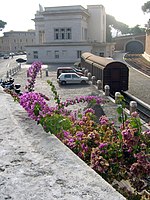Portal:Trains/Selected article/Week 14, 2009
Rail transport in Vatican City consists of two 300-metre (980 ft) sets of rail tracks within Vatican City, the shortest national railway system in the world. Access to Italian rail lines was guaranteed by the Lateran Treaty (1929), and tracks and a station were constructed during the reign of Pope Pius XI. That rail travel was a prerequisite for the mass pilgrimages of the 19th century, beginning with those at Lourdes circa 1858, and was one factor that softened opposition to such technology within the Roman Curia. The first locomotive entered the Vatican in March 1932. A Railway Convention was ratified between Italy and Vatican City on September 12, 1934, and in October 1934 the Ministry of Public Works handed over the completed rail lines to Vatican City and Ferrovie dello Stato, respectively. Most railway traffic in Vatican City consists of freight goods importation, although the railway has occasionally carried passengers, usually for symbolic or ceremonial reasons. The planned papal train of Pius XI was never constructed and the Vatican has never employed any railway workers or registered any rolling stock. Pope John XXIII on October 4, 1962, became the first pope to use the Vatican railway during his pilgrimage to Loreto and Assisi one week before the beginning of Second Vatican Council using the Italian presidential train.
Recently selected: Asker Line - Meråker Line - Alberta and Great Waterways Railway scandal

